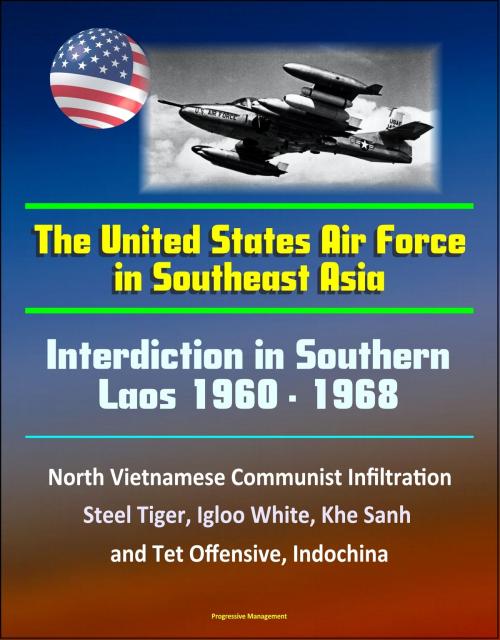Interdiction in Southern Laos 1960-1968: The United States Air Force in Southeast Asia - North Vietnamese Communist Infiltration, Steel Tiger, Igloo White, Khe Sanh and Tet Offensive, Indochina
Nonfiction, History, Military, Vietnam War, Asian, Aviation| Author: | Progressive Management | ISBN: | 9781310272646 |
| Publisher: | Progressive Management | Publication: | August 21, 2015 |
| Imprint: | Smashwords Edition | Language: | English |
| Author: | Progressive Management |
| ISBN: | 9781310272646 |
| Publisher: | Progressive Management |
| Publication: | August 21, 2015 |
| Imprint: | Smashwords Edition |
| Language: | English |
Professionally converted for accurate flowing-text e-book format reproduction, this U.S. Air Force (USAF) publication examines American air operations in Laos during the Vietnam War. Throughout the War in Southeast Asia, Communist forces from North Vietnam infiltrated the isolated, neutral state of Laos. Men and supplies crossed the mountain passes and travelled along an intricate web of roads and jungle paths known as the Ho Chi Minh Trail to the Viet Cong insurgents in South Vietnam. American involvement in Laos began with photo-reconnaissance missions and, as the war in Vietnam intensified, expanded to a series of air-ground operations from bases in Vietnam and Thailand against fixed targets and infiltration routes in southern Laos. U.S. Air Force leaders and aircrews flying interdiction missions over Laotian territory faced a unique set of challenges. Their efforts were plagued by political controversies, daunting weather, rugged terrain, a tenacious foe, and above all a bewildering array of rules of engagement limiting the effectiveness of air operations. Interdiction in Southern Laos, 1960-1968 examines this complex operational environment. Many of these issues—particularly those relevant to conducting a politically sensitive, limited war from foreign bases, with a commitment to minimizing civilian casualties—are still relevant today and for the foreseeable future as the modern Air Force meets its responsibilities in an ever-changing global environment.
Of the diverse American military actions instituted from 1960 to 1973 to prevent the spread of communism in the Indochina peninsula, none were more complex than those in Laos. There, two highly restricted air and air-ground wars were fought. One was waged in the north to assure the independence, territorial integrity, and neutrality of the Laotian government, guaranteed by the 1954 and 1962 Geneva agreements. The other was waged in the south to arrest the infiltration of manpower and supplies from communist North Vietnam to the Viet Cong insurgents in non-communist South Vietnam. This volume addresses the first phase of the latter war, 1960 to January 1968. It focuses on the activities of the United States Air Force in carrying out a variety of mandated anti-infiltration measures. Among the complexities of warfare in Laos discussed, one deserves mention from the outset. This is the role of a series of American ambassadors to Laos who were fated to serve as the principal American military as well as political representatives in that country. Their unique position stemmed from the two Geneva agreements that forbade the Laotian government from entering into any formal foreign military alliance.
I. Early Efforts to Reduce North Vietnamese Infiltration Through Laos * II. Expansion of Counterinfiltration Activities * III. The Beginning of the Steel Tiger Program * IV. Expansion of the Aerial Anti-infiltration Campaign, July-December 1965 * V. New Aerial Programs and Tactics Against Infiltration, January-June 1966 * VI. Further Increase in Enemy Strength and Additional Air Programs, July-December 1966 * VII. Renewed Hope in the Anti-infiltration Effort, January-May 1967 * VIII. Auguries of Eventual Victory Against Infiltration, July 1967-January 1968 * IX. Inauguration of the Sensor-Oriented Anti-Infiltration System (Igloo White) * X. Prelude to Khe Sanh and the Tet Offensive
Professionally converted for accurate flowing-text e-book format reproduction, this U.S. Air Force (USAF) publication examines American air operations in Laos during the Vietnam War. Throughout the War in Southeast Asia, Communist forces from North Vietnam infiltrated the isolated, neutral state of Laos. Men and supplies crossed the mountain passes and travelled along an intricate web of roads and jungle paths known as the Ho Chi Minh Trail to the Viet Cong insurgents in South Vietnam. American involvement in Laos began with photo-reconnaissance missions and, as the war in Vietnam intensified, expanded to a series of air-ground operations from bases in Vietnam and Thailand against fixed targets and infiltration routes in southern Laos. U.S. Air Force leaders and aircrews flying interdiction missions over Laotian territory faced a unique set of challenges. Their efforts were plagued by political controversies, daunting weather, rugged terrain, a tenacious foe, and above all a bewildering array of rules of engagement limiting the effectiveness of air operations. Interdiction in Southern Laos, 1960-1968 examines this complex operational environment. Many of these issues—particularly those relevant to conducting a politically sensitive, limited war from foreign bases, with a commitment to minimizing civilian casualties—are still relevant today and for the foreseeable future as the modern Air Force meets its responsibilities in an ever-changing global environment.
Of the diverse American military actions instituted from 1960 to 1973 to prevent the spread of communism in the Indochina peninsula, none were more complex than those in Laos. There, two highly restricted air and air-ground wars were fought. One was waged in the north to assure the independence, territorial integrity, and neutrality of the Laotian government, guaranteed by the 1954 and 1962 Geneva agreements. The other was waged in the south to arrest the infiltration of manpower and supplies from communist North Vietnam to the Viet Cong insurgents in non-communist South Vietnam. This volume addresses the first phase of the latter war, 1960 to January 1968. It focuses on the activities of the United States Air Force in carrying out a variety of mandated anti-infiltration measures. Among the complexities of warfare in Laos discussed, one deserves mention from the outset. This is the role of a series of American ambassadors to Laos who were fated to serve as the principal American military as well as political representatives in that country. Their unique position stemmed from the two Geneva agreements that forbade the Laotian government from entering into any formal foreign military alliance.
I. Early Efforts to Reduce North Vietnamese Infiltration Through Laos * II. Expansion of Counterinfiltration Activities * III. The Beginning of the Steel Tiger Program * IV. Expansion of the Aerial Anti-infiltration Campaign, July-December 1965 * V. New Aerial Programs and Tactics Against Infiltration, January-June 1966 * VI. Further Increase in Enemy Strength and Additional Air Programs, July-December 1966 * VII. Renewed Hope in the Anti-infiltration Effort, January-May 1967 * VIII. Auguries of Eventual Victory Against Infiltration, July 1967-January 1968 * IX. Inauguration of the Sensor-Oriented Anti-Infiltration System (Igloo White) * X. Prelude to Khe Sanh and the Tet Offensive















